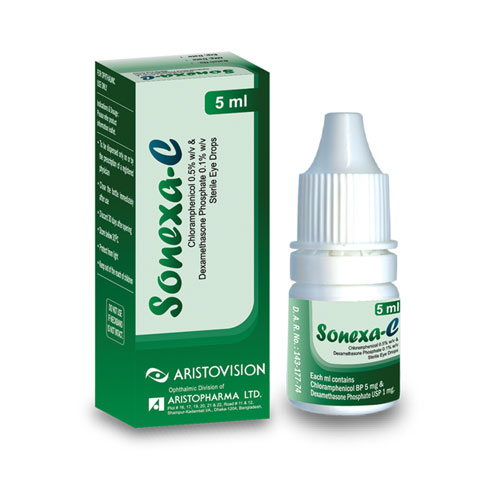
SONEXA – C Eye drops
Therapeutic Class
Antibiotic & Steroid
Indications
For steroid-responsive inflammatory ocular conditions for which a corticosteroid is indicated and where bacterial infection or a risk of bacterial ocular infection exists. For inflammatory conditions of the palpebral and bulbar conjunctiva, cornea and anterior segment of the globe where the inherent risk of steroid use in certain infective conjunctivitis is accepted to obtain a diminution in oedema and inflammation. For chronic anterior uveitis and corneal injury from chemical, radiation or thermal burns, or penetration of foreign bodies. It is also effective postoperatively.
Chemical Composition
Each ml contains Chloramphenicol BP 5 mg and Dexamethasone Phosphate USP 1 mg.
Packaging
Each plastic dropper bottle contains 5 ml eye drops.
Dosage & Administration
1 drop into the affected eyes every 3 or 4 hours, or more frequently if deemed advisable by the prescribing physician. Administration should be continued during day and night for the first 48 hours, after which the interval between applications may be increased. Treatment should be continued for at least 48 hours after the eye appears normal
Contraindications
It is contraindicated in fungal, viral, tuberculous and other infections of the eye and in glaucoma. It is also contraindicated in patients hypersensitive to any component of this product. The use of anti-infective and steroid is always contraindicated after uncomplicated removal of a corneal foreign body.
Side Effects
Blood dyscrasias have been reported in association with the local use of chloramphenicol. Allergic sensitization may occur with the local use of chloramphenicol. Elevation of intraocular pressure with possible development of glaucoma, and infrequent optic nerve damage, posterior subcapsular cataract formation, and delayed wound healing may occur with the use of steroid. Secondary infection has occurred after long term use of combinations containing steroid and antimicrobial. Fungal infections of the cornea are particularly prone to develop with the long term application of steroid. Secondary bacterial ocular infection following suppression of host responses also occur.

